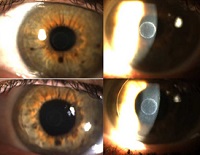Visual Prognosis after Explantation of a Corneal Shape-Changing Hydrogel Inlay in Presbyopic Eyes
Medical hypothesis discovery and innovation in ophthalmology,
Vol. 8 No. 3 (2019),
20 September 2019
,
Page 139-144
Abstract
The purpose of this case series is to report visual outcomes in patients who underwent explantation of the Raindrop® hydrogel corneal inlay. Retrospective chart review comprising four cases of explantation of the Raindrop® corneal shape-changing hydrogel inlay: pre-implantation, pre-explantation, and post-explantation values for uncorrected distance visual acuity, uncorrected near visual acuity, and corrected distance visual acuity (CDVA) were measured; keratometric and tomographic data were collected using the Pentacam system (Oculus, Inc). Three eyes were explanted for progressive haze after implantation that persisted even after removal; one eye was explanted due to poor visual acuity with no haze formation. All patients experienced decreased unaided and corrected distance visual acuity. Persistent increase in corneal thickness and mean keratometry was noted post-explantation. All four patients regained their original near visual acuities, but one patient had persistent one-line loss in CDVA. There are long lasting tomographic corneal changes following Raindrop inlay explantation. In addition, persistent increased corneal thickness could be related to semi-permanent changes in corneal structure and may account for residual haze experienced by patients. After explantation, patients may not return to baseline CDVA.
References
PMA P150034: FDA Summary of Safety and Effectiveness Data (SSED): 1-49. 2016. Available from: https://www.fda.gov/media/123081/download.
ReVision Optics Inc. Raindrop ® Near Vision Inlay Professional Use Information. 2017 [cited 2017 March]. Available from: https:// www.accessdata.fda.gov/ cdrh_docs/pdf15/p150034c.pdf.
Hovanesian J. ReVision Optics goes out of business. 2018 [cited 2018 Feb 1st]. Available from: https://www.healio.com/ophthalmology/ophthalmic-business/news/online/%7Bcbbd13e9-f879-4516-96c9-b096a30193af%7D/revision-optics-goes-out-of-business.
FDA. Increased Risk of Corneal Haze Associated with the Raindrop Near Vision Inlay: FDA Safety Communication [cited 2019 May 29]. Available from: https://www.fda.gov/medical-devices/safety-communications/increased-risk-corneal-haze-associated-raindrop-near-vision-inlay-fda-safety-communication.
Whitman J, Dougherty PJ, Parkhurst GD, Olkowski J, Slade SG, Hovanesian J, et al. Treatment of Presbyopia in Emmetropes Using a Shape-Changing Corneal Inlay: One-Year Clinical Outcomes. Ophthalmology. 2016;123(3):466-75. doi: 10.1016/j.ophtha.2015.11.011 pmid: 26804761
RAINDROP®Near Vision Inlay Professional Use Information [cited 2019 May 17]. Available from: www.raindropinlay.com.
Garza EB, Gomez S, Chayet A, Dishler J. One-year safety and efficacy results of a hydrogel inlay to improve near vision in patients with emmetropic presbyopia. J Refract Surg. 2013;29(3):166-72. doi: 10.3928/1081597X-20130129-01 pmid: 23446012
Chayet A, Barragan Garza E. Combined hydrogel inlay and laser in situ keratomileusis to compensate for presbyopia in hyperopic patients: one-year safety and efficacy. J Cataract Refract Surg. 2013;39(11):1713-21. doi: 10.1016/j.jcrs.2013.05.038 pmid: 24021565
Ni Dhubhghaill S, Rozema JJ, Jongenelen S, Ruiz Hidalgo I, Zakaria N, Tassignon MJ. Normative values for corneal densitometry analysis by Scheimpflug optical assessment. Invest Ophthalmol Vis Sci. 2014;55(1):162-8. doi: 10.1167/iovs.13-13236 pmid: 24327608
Ljubimove A, Saghizadeh M. Progress in corneal wound healing. Prog Retin Eye Res. 2016;49(310):17-45. doi: 10.1016/j.preteyeres.2015.07.002.Progress
Chu R, Lee BR. Diagnostic and Management Tool for Monitoring Patients Implanted with a Shape-Changing Corneal Inlay. Case Rep Ophthalmol. 2018;9(1):190-6. doi: 10.1159/000484436 pmid: 29681835
Ong HS, Chan AS, Yau CW, Mehta JS. Corneal Inlays for Presbyopia Explanted Due to Corneal Haze. J Refract Surg. 2018;34(5):357-60. doi: 10.3928/1081597X-20180308-01 pmid: 29738595
Amigo A, Martinez-Sorribes P, Recuerda M. Late-onset refractive shift after small-aperture corneal inlay implantation. J Cataract Refract Surg. 2018;44(5):658-64. doi: 10.1016/j.jcrs.2018.03.029 pmid: 29891159
Lang AJ, Holliday K, Chayet A, Barragan-Garza E, Kathuria N. Structural Changes Induced by a Corneal Shape-Changing Inlay, Deduced From Optical Coherence Tomography and Wavefront Measurements. Invest Ophthalmol Vis Sci. 2016;57(9):OCT154-61. doi: 10.1167/iovs.15-18858 pmid: 27409467
Tomita M, Kanamori T, Waring GOt, Nakamura T, Yukawa S. Small-aperture corneal inlay implantation to treat presbyopia after laser in situ keratomileusis. J Cataract Refract Surg. 2013;39(6):898-905. doi: 10.1016/j.jcrs.2013.01.034 pmid: 23688876
Tomita M, Kanamori T, Waring GOt, Yukawa S, Yamamoto T, Sekiya K, et al. Simultaneous corneal inlay implantation and laser in situ keratomileusis for presbyopia in patients with hyperopia, myopia, or emmetropia: six-month results. J Cataract Refract Surg. 2012;38(3):495-506. doi: 10.1016/j.jcrs.2011.10.033 pmid: 22340607
Limnopoulou AN, Bouzoukis DI, Kymionis GD, Panagopoulou SI, Plainis S, Pallikaris AI, et al. Visual outcomes and safety of a refractive corneal inlay for presbyopia using femtosecond laser. J Refract Surg. 2013;29(1):12-8. doi: 10.3928/1081597X-20121210-01 pmid: 23311737
Moshirfar M, Desautels JD, Wallace RT, Koen N, Hoopes PC. Comparison of FDA safety and efficacy data for KAMRA and Raindrop corneal inlays. Int J Ophthalmol. 2017;10(9):1446-51. doi: 10.18240/ijo.2017.09.18 pmid: 28944206
Malandrini A, Martone G, Menabuoni L, Catanese AM, Tosi GM, Balestrazzi A, et al. Bifocal refractive corneal inlay implantation to improve near vision in emmetropic presbyopic patients. J Cataract Refract Surg. 2015;41(9):1962-72. doi: 10.1016/j.jcrs.2015.01.018 pmid: 26603405
Moarefi MA, Bafna S, Wiley W. A Review of Presbyopia Treatment with Corneal Inlays. Ophthalmol Ther. 2017;6(1):55-65. doi: 10.1007/s40123-017-0085-7 pmid: 28390052
Jacob S, Kumar DA, Agarwal A, Agarwal A, Aravind R, Saijimol AI. Preliminary Evidence of Successful Near Vision Enhancement With a New Technique: PrEsbyopic Allogenic Refractive Lenticule (PEARL) Corneal Inlay Using a SMILE Lenticule. J Refract Surg. 2017;33(4):224-9. doi: 10.3928/1081597X-20170111-03 pmid: 28407161
Allotex. The Natural Solution for Vision Correction [cited 2019 May 28]. Available from: https://allotex.com/science/clinical-data/.
- Abstract Viewed: 673 times
- Free Full Text PDF Downloaded: 591 times


